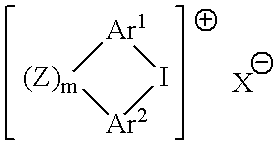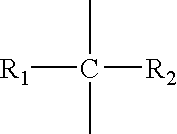Tackified thermoplastic-epoxy pressure sensitive adhesives
a thermoplastic and adhesive technology, applied in the direction of heat-activated film/foil adhesives, film/foil adhesives, weaving, etc., can solve the problems of not teaching or disclosing the inclusion of tackifiers, and the inclusion of pressure sensitive adhesives, etc., to achieve easy processing, improve the effect of adhesion, and retain porosity
- Summary
- Abstract
- Description
- Claims
- Application Information
AI Technical Summary
Benefits of technology
Problems solved by technology
Method used
Image
Examples
example 1
[0078]Samples A–K, discussed below, were mixtures of Kraton™ D1107 thermoplastic, Escorez™ 1310LC tackifier, Epon™ 828 epoxy, Amicure™ CG-1400 curing agent (5% by weight relative to the epoxy) and solvent and had the compositions indicated in Table I:
[0079]
TABLE IThermoplasticTackifierEpoxyCure AgentSolventSample(gm)(gm)(gm)(gm)(gm)A15153.00.15132*B15156.00.30144*C20103.00.15132*D20106.00.30144*E24.06.03.00.15132*F24.06.06.00.30144*G7.57.51.50.08 66**H7.57.53.00.15 72**I7.57.51.50.08 66**J7.57.53.00.15 72***toluene;**tetrahydrofuran (THF)
[0080]Samples A—F were hand coated on 4 mil (0.1 mm) thick PET backing to give a coating thickness of 1 mil (0.025 mm) after being allowed to dry. Strips were then rolled onto tigum rubber with a 5 kg rolling wheel. Some strips with affixed tigum for samples A and B were then thermally cured by sandwiching between teflon-coated steel plates and heating for 15 minutes at 177° C. Peel tests were performed at 30 cm / minute for four repetitions. Upon pee...
example 2
[0084]Coating runs of three formulations were performed using a 30 mm Werner & Pfleiderer (ZSK-30) co-rotating twin screw extruder with 12 zones. (Werner & Pfleiderer, Germany). The extruder was configured with forward kneading blocks in zones 2, 4, 6 and 8 and forward conveying elements in the remaining zones. The screw speed was 250 RPM and the thermoplastic flow rate was maintained at 4.5 kg / hr.
[0085]Tackified Kraton pellets were used for convenience of feeding. The tackified pellets were purchased from H. B. Fuller Company (St. Paul, Minn.) and consisted of 50% by weight Kraton™ D1107 and 50% by weight Escorez 1310LC™, with small amounts of talcum powder to prevent sticking. Liquid Epon™ 828 was used as the epoxy, with 2% by weight of photocatalyst added to the epoxy. The Tackified Kraton pellets were fed into zone 1 of the extruder using a weight loss feeder. The epoxy was fed into zone 5 using a Zenith gear pump. (Zenith Pumps Div., Parker Hannifin Corp., Sanford, N.C.). The w...
example 3
[0096]The procedure of Example 2 was repeated using PAO and P-90 tackifier, except that the PAO and tackifier were seperately fed as follows: The PAO flow rate was kept at 10 lbs / hr. The PAO was fed into zone 1 using a 4″ Bonnot single screw extruder kept at 365° F., the tackifier was melted and fed into zone 3 using a Zenith gear pump. Liquid epoxy was fed into zone 5 using a Zenith gear pump. The samples were UV cured several days after coating at a UV A dose of 0.5 J / cm2. Compositions and test results are reported for samples T–W and comparative sample S in Table VII:
[0097]
TABLE VIIPeel, curedDrop Shear,MaterialsWeight Ratios(N / dm)cured (min.)SPAO / P-90100 / 304221TPAO / P-90 / 828100 / 30 / 52478UPAO / P-90 / 828100 / 30 / 736112VPAO / P-90 / 4221100 / 30 / 53247WPAO / P-90 / 4221100 / 30 / 203756
[0098]These results demonstrate acceptable peel values and greatly improved shear values for the materials of the present invention.
PUM
| Property | Measurement | Unit |
|---|---|---|
| Percent by mass | aaaaa | aaaaa |
| Percent by mass | aaaaa | aaaaa |
| Percent by mass | aaaaa | aaaaa |
Abstract
Description
Claims
Application Information
 Login to View More
Login to View More - R&D
- Intellectual Property
- Life Sciences
- Materials
- Tech Scout
- Unparalleled Data Quality
- Higher Quality Content
- 60% Fewer Hallucinations
Browse by: Latest US Patents, China's latest patents, Technical Efficacy Thesaurus, Application Domain, Technology Topic, Popular Technical Reports.
© 2025 PatSnap. All rights reserved.Legal|Privacy policy|Modern Slavery Act Transparency Statement|Sitemap|About US| Contact US: help@patsnap.com



